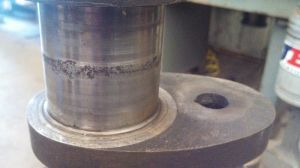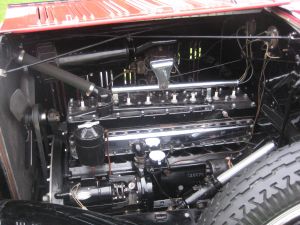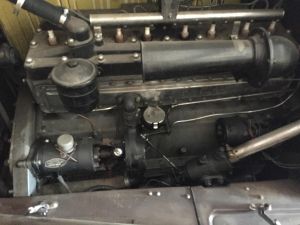- Home
- About Us
- Join/Renew
- Member Benefits
- Member Pages
- Log In
- Help
- Museum Store
So I was thinking the other day, I know I need to stop that.
Since Pierce Arrow made such great vehicles, especially the drivetrain –
How many miles would one expect to get out of a proper, modern rebuild on a Pierce engine?
Modern metals, processes, lubricants and maintenance should dictate that a properly done rebuild would last hundreds of thousands of miles, no?
Pierce engines are low compression, low revving engines so they should last a very long time with proper maintenance and modern lubricants.
What do you guys think?
Wishful thinking on my part?
Or would a properly rebuild engine be just fine for my grandkids to enjoy well into their adult years?
Provided they don’t sell it first. Haha
And they can get gas!!!
Hi Craig.
The biggest factors to increase longevity will be installing a very good air filter, and a very good oil filter. The very best air and oil filtration from when the Pierce Arrow engines were manufactured is at best very poor by todays standards.
The biggest contributor to engine wear is the dirt in the air brought into the engine, compressed in the cylinders, which concentrates the dirt, then the pressures of combustion, and forcing the piston down. Some of the dirt gets past the rings, wearing the cylinder walls, rings and pistons. Then the dirt is inside the engine crankcase, and is washed into the oil. Soon ht oil has a lot of dirt in circulation that then is like a grinding compound, wearing the crankshaft, camshaft and oil pump bearing surfaces.
Engines did not get any form of air filtration until the late ’20’s, Even the best air filtration in the early ’30’s was relatively poor compared to modern air filtration.
Oil filtration was limited to a copper or brass screen, which did not remove anything smaller than the head of a pin from the oil.. This dirty, contaminated oil first caused wear in the oil pump, then throughout the engine’s pressure-lubricated parts.
Next will be to have the engine run for at least 30 minutes ANY time the engine is started. It is VERY hard on engines to start up and run only a few minutes then be shut down cold. These big engines take quite a while to get the oil and water up to correct operating temperatures. And an engine needs to be at operating temperatures for at least 20 minutes for the byproducts of a cold start to be evaporated out of the oil. Otherwise the oil becomes saturated with water and acids, and with the oil, it becomes sludge.
Engines must have coolant thermostats operational so that the engine warms up quickly, and up to at least 160-170 degrees. The oil temperature is much slower to increase, and getting the oil up to temperature is critical for long engine life.
So, yes, a rebuilt engine in or Pierce Arrow cars has a chance of lasting several times as long as it was expected to last when it was new. But how we treat our engines is a major factor.
Examples of getting very little life from an engine: short trips. like driving only 2-5 miles to work, Then back home. Never driving the car for more than 20 minutes.. This type of driving will sludge up any engine. Oil changes need to be done on a time schedule, and much more often than what is considered ‘normal’. Cold climates will make these frequent oil changes even more important.
Examples of extreme long engine life: A long-haul truck that is designed with huge, high quality air filters and oil filtration systems. These engines are started and often run for days before shutting down.
I have a T-300 Kenworth ‘expediter’ truck that I purchased with 1,118,000 miles.. Yes, more than a million road miles.
I have the maintenance records for this truck. The engine has never been apart. The oil was changed usually between 12,000 and 18,000 miles. Air, fuel and oil filters changed at the same time.
The worst, most abusive miles on this truck have been put on it by myself: a 5 mile drive to the gas-station to fill up the fuel tanks, then back home. Or worse: start it up and move it out of the way of other vehicles and trailers in my yard.
Unfortunately our collector-cars do not get enough long running time. These short runs have the greatest effect on our engine longevity.
No doubt, our modern lubricants will help our engines to live a much longer life, but how and how often we drive and operate our cars will have the greatest effect.
Greg Long
Here is an example of what corrosive acids in our engines does to the bearing surfaces.
The ring of corrosion is where the main bearing has an oil-distribution groove. So there was a small quantity of oil against this area of the crank journal.
Greg

To add to Greg’s excellent comments and especially to the photo he posted above,
You want to be sure to always change the oil before putting a car away for the winter or for any long period of time. Not driving a car for months while it has old contaminated oil is what causes the corrosion in the photo Greg posted. Always store a car with fresh oil. And lest it go unsaid, change the oil then run the engine to splash all the new oil around the engine.
I sold a Franklin to a fellow about 20 years ago. I rebuilt the engine and put 10,000 trouble free miles on it. This guy has NEVER changed the oil in 20 years. His claim is that he only drives it once a year to a show. . . . and he’s a total freaking cheapskate. That poor engine will require a whole new rebuild from all the acids and sludge accumulated. It was a nice car. I’m not sure I’d want it back now.
— Luke
This topic was also discussed in a lengthy thread a month or so ago. To add to the discussion, another point about temperature and engine wear. Studies way back showed that coolant temperatures of 160 and below kept the oil thicker and led to more oil getting past the rings and burning, leading to more deposits which increased piston ring, piston ring groove, and cylinder wear. Thick weight oils have the same effect, and of course engines during warmup. Ironically, the trend in piston ring design through the years shows that the problem for most engines is scraping the excess oil down, not too little oil on the cylinder walls. Moot testimony to this is the Packard senior engines. Before 1936 they used 3 compression rings and one cast iron oil ring, same as Pierce. In 1937 they replaced the #3 compression for a second oil scraper ring, so it had two compression and 2 oil rings. Customer complaints of excess oil consumption were to be dealt with by adding springs behind the rings to increase pressure.
Once pressurized cooling systems came into play coolant temps were raised to 180 -195 and above. One study found that wear was minimized with 20 weight oil and coolant temperatures above 180. The rings were less effective at scraping the excess oil down when thicker.
Years ago I had my shutter thermosylphon recharged to have a 180 opening temperature instead of 160 (it was an option on some cars) – which also helped the passenger heater effectiveness.
Compared to the air filtration issue this factor is probably more academic than practical given the really low miles any of them will likely ever see before it becomes illegal to self drive your car without computer. Meanwhile, it underscores the goodness of getting engine temperatures up by driving them (not idling or puttering around at 25 mph) and not using thick oils.
Personally I do not put my cars away for winter, I try to drive them at least once a month to avoid “death by museum” syndrome. Not always possible depending on the weather of course (like this week with a mix of heavy snow and rain). I like to get all the lubricants splashed and worked around a bit to keep the seals from drying out. The tires also develop flat spots from sitting that are annoying at highway speeds, unless you jack the cars up which makes it very inconvenient to drive them somewhat regularly.
Jim
I realize what short trips will do to an engine.
Even modern cars that are used mainly for short trips will fall into the severe duty category and should be serviced as such.
Short trips without fully warming up the engine are not only hard on the engine but are very hard on the exhaust system as well.
The acids combined with the moisture still in a not fully warmed up exhaust system with rot out an exhaust system very quickly.
Luckily for those of us with a Pierce 8, there is plenty of room around the carb to add a modern pod air filter.
That is why I mentioned modern rebuild methods and maintenance.
One issue for my car would be adding an oil filter system that was not available at the time the car was new.
Sure, I could adapt a system from a later Pierce but it would not be correct.
Then again, who cares about being perfectly correct unless you’re having the car competitively judged on a regular basis?
Not having an oil filter has always bothered me and I’d have to look at the block to see if the block is even tapped for oil filter lines.
If you are willing to forgo originality, adding some sort of positive crankcase ventilation will decrease the amount of oil contaminants. After improved oil and air filtering, that would be another great step forward which should increase the life expectancy of a motor.
Actually, Pierce-Arrow engines had a type of crankcase ventilation. Starting in 1921 with the Series 32 cars, fumes from the crankcase were drawn into the carburetor air supply and burned in the engine.
Paul, Where do the fumes get drawn into the intake air? Inside the block, where the warmed air goes through the block from the right side of the block to the carb on the left? -Dave
Paul,
Was there some method of regulating the airflow, like a PCV valve would provide? Do you have a picture of the Series 33’s ventilation system?
On my ’29, the rear valve cover has a tube where a short piece of tubing would connect and then that would connect to the air filter.
Pretty much the same setup that cars in the 60’s had before they went to one with a PCV valve.
Craig,
Mine is the same way, with no filter at all. California cars were built with extra ventilation in the 60’s. Perhaps we can start there. I thought John Cislak was working on a filter system for the early 8’s.
1929 Pierce Arrow engines WERE equipped with an replaceable element oil filter. It was bolted to the front left side of the engine, using the first few bolts of the water jacket.
This filter was of the ‘bypass’ type: It had a small oil line that ‘bled’ off a bit of the oil from the main oil gallery, it passed this oil through the filter element, and returned it to the crankcase/oil pan. It ‘bled-off’ a bit of the available oil supply to the engine. The system had a small orifice in one of the fittings or pipes that limited the amount of oil pressure and supply being ‘bled’ from the main oil gallery.
Here is a photo of a non-original bypass-type oil filter on a ’29 engine.
The original oil filters were designed with a pot-metal fitting that had both the inlet and return lines attached. The entire canister was discarded when replaced.
Greg Long
No luck with the photo, I’ll shrink one and try again.
Greg
I think this might work now.
Greg

Different car, similar type of non-original bypass oil filter.
Greg

As always, Greg is right. They do have an oil filter. I was talking about the air filter. Thanks for the pics on the oil filter. Mine has one, with an AC brand P-115 cartridge filter. I found a WIX filter that was close, but doesn’t have the same diameter in the middle. The guys who sell farm equipment parts think they might be able to match something up.
Greg, I sent you an email a while ago on your earthlink account, probably didn’t go through. Should I resend it to the gmail account?
Bob
Oil and air filters really are a must, but I’d say that an air filter is easier to put on any car and even more important for reasons already mentioned. Without an oil filter you could just change the oil frequently. Without an air filter, you are harming the engine every time you drive it.
I’ve liked the washable K&N filters. I’ve put them on several cars. The nice thing is you can go onto their website and order any shape, any dimension that might fit your car. They aren’t custom made, but they offer such a wide range of sizes that you pretty much can find something that fits the space you’d like to mount it.
https://www.knfilters.com/universal/universal.htm
— Luke
Pierce Arrow sold a Purolator add on filter through all the dealerships for the early eight cars that did not come with them from the factory. The kit was a filter, fittings, brackets, and lines. They were offered sometime in 1930, and somewhere in my papers I have an original copy of the factory paperwork on them. Ed
